Yesterday morning, we started up the main engine just past daybreak for a planned run from Widewall Bay along the west coast of Hoy and the Mainland in the Orkney Islands. But the anchor was locked down solidly on the bottom. That’s happened before and we have our tricks. Dropping another 100 feet and pulling straight into the wind usually works but it didn’t this time. Pulling at 90 degrees until the anchor moves and then pulling it up into the wind often frees an anchor when working to one side or the other, but the anchor wouldn’t shift an inch in either direction.
In our 25 years of boating, we’ve only once lost an anchor, when anchored in British Columbia’s Indian Arm area. On that one, we were in 70 feet of water with 7-ft visibility and a water temperature below 50F (10 C). The anchor was tangled in logging cabling. We hated the idea of diving into a rusty mass of log cabling where the risk of entanglement was high. We reluctantly dropped a 44lb Bruce anchor and 200ft of chain and in retrospect, it felt like the right decision.
This morning we were facing what should be an easier problem. We were in 14 ft of 58F water with closer to 20-ft visibility. That makes the dive considerably easier and our 154 lb (70kg) Rocna with 500 feet of 7/16-inch chain is far too expensive to give up without a fight. This morning we got our dive gear organized just past day break. I hate cold water, so was planning to use our dry suits, but it’s been two years since our last cold water dive and the wrist seals had failed. I considered taping the wrists off to my arm with the handyman’s secret weapon (duct tape) but eventually elected to use our new 5-mil wetsuits. The 5-mil is thick enough that it’s plenty for 58F water. What makes this O’Neill wetsuit super-effective is that the wrist, ankle, and neck seals are quite tight. Very little water leaks in.
In order to get the anchor free, we first needed to get the the boat off that anchor. The winds were blowing 25 kts with gusts to 30 this morning, so the boat was pulling back hard. We first dropped another 50 ft of rode and went 60 ft upwind, beyond where our main anchor was. We then dropped our spare anchor on its short chain rode with the remainder being 1-inch diameter rope. This anchor is a Guardian G-85 which is quite large but not that heavy, and can be handled by a single person without windlass assist. We lowered it down and let out 60 ft so that we would be floating directly over our disabled anchor.
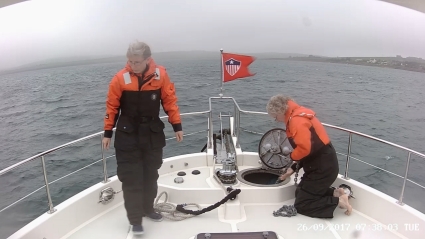
|
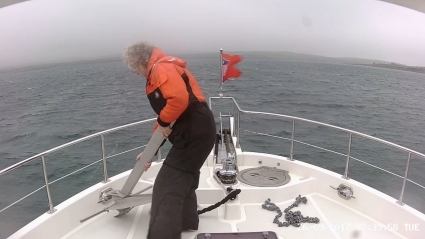
|
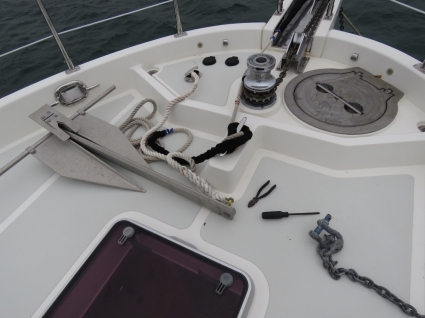
|
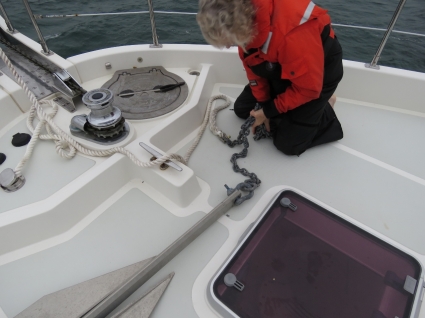
|
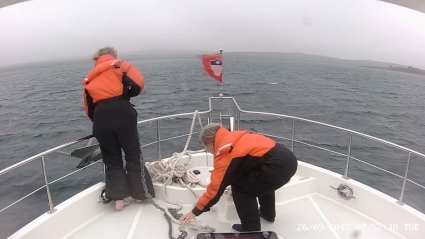
|
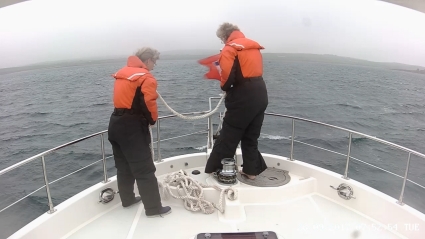
|
It was a great plan and it would have been super convenient but the spare anchor couldn’t get a bite in this hard bottom material with some weed. It would hold for a few tens of seconds but then slip again, and eventually we returned all the way back to swinging on the main anchor. We just kept slowly slipping back. It was looking like we were going to need to re-anchor when suddenly it took a perfect set and the boat stopped like it had hit a brick wall. It was a relief to see the boat finally anchored on the spare anchor so we could work to free the main anchor.
I threw on my diving equipment and jumped in the water and started swimming forward. About 120 ft forward of the boat I came upon our main anchor. Lying on its side, it didn’t even look like it would hold the boat, much less not be recoverable. But as I swam closer, the story became more clear. A massive anchor chain, with single links of nearly 12 inches, stretched as far as I could see to the left and off into the distance to the right. This old anchor chain was so massive that our Rocna 70 anchor fluke had somehow found its way to the center of one of the links. The anchor was actually poking through one of the huge links by about four inches. And, after 30-knot gusts overnight, the anchor was actually sprung in place. I could just barely shift our anchor left and right but the link we were ensnarled in moved with it. It was as if the the two parts were welded together.
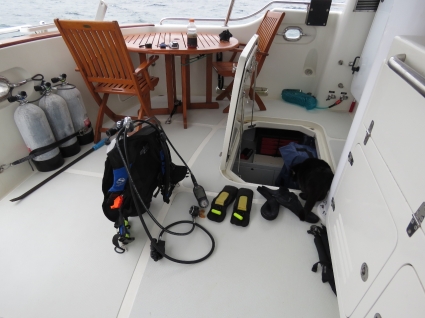
|

|
Fortunately, I had brought down a very strong 3-ft-long pry bar. Using the pry bar, I eventually got enough metal between our anchor and the large chain and popped it free after applying close to all the force I could muster. The anchor was now loose in the link but still had four inches of fluke through the chain. I couldn’t budge the massive links we were embedded in, so needed to pull our anchor and its attached chain back 4-5 inches to pop the anchor free. It turns out dragging 100 ft of 7/16-in chain along the sea bottom is way harder than one might expect. I wouldn’t have succeeded with that task without the pry bar. Eventually I was able to lift our anchor up over the old chain. We were free!
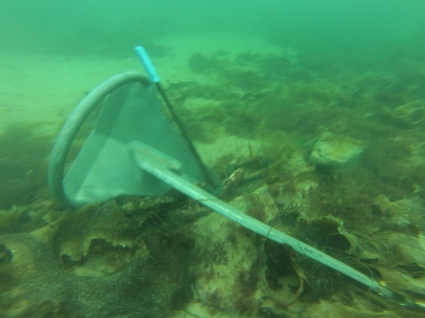
|
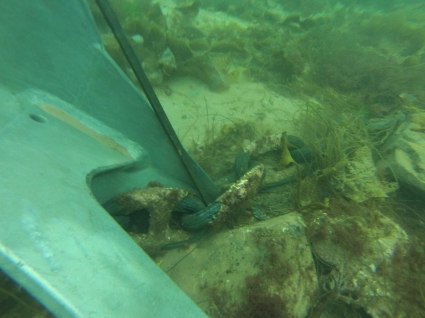
|
I swam back to the boat, signaled to Jennifer who was watching from the bow that all was good, and passed up the pry bar. I then decided to play it safe and swim out to the spare anchor. I followed the rope rode and found the spare anchor was fouled in the same discarded chain that appears to cross the entire bay. The good news was that the flukes went under the chain so it was hooked in a big way but wasn’t jammed within the links of the big cross-bay chain. The bad news was the flukes on this large Danforth style anchor are several feet long and so the anchor needed to be pulled back a couple of feet to free it. But the boat was currently anchored on this anchor in 20 to 30 kt winds, so pulling it back likely would be impossible.
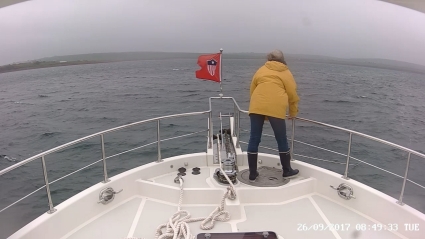
|
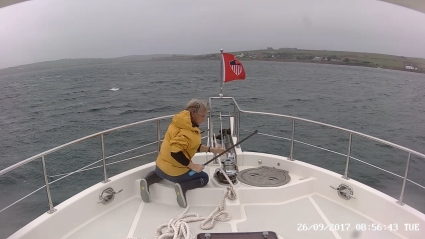
|
It turns out that a big rope rode actually stretches quite a bit and there was some bouncing at the end of a big gusts. I put one fin on each side of our anchor on the big chain we were fouled in and pulled as hard as I could on our anchor. For close to a minute, all my pulling made no difference whatsoever, but we eventually got a big gust that stretched the rode and on rebound the boat load came off the anchor. As the load came off, I got the two feet of anchor motion I needed and just got the anchor free. The funny thing is I was now dragging behind the big Danforth style anchor as it slid along the hard bottom not getting a grip. I worked for a few minutes trying to get the anchor set. I could get it dug in and it would hold for a minute or so before a big gust tore it free again.
I wasn’t happy to have the boat essentially unanchored as I swam back, but there wasn’t much I could do. And it would soon pull back far enough to catch the main anchor where I had left it still sitting on the bottom, and that should stop the boat motion. We did have room for hundreds of feet of slip without worry of dragging into shore, so I continued to swim back. I dropped off the scuba gear while Jen checked to ensure we were no longer slipping back. The main anchor had stopped the slide so we were fine. We pulled in some of the main anchor role so we could get the boat over the spare anchor and I could hand-retrieve it. Then we brought in the main anchor as usual.
We have anchored all around the world, including patchy sand with easy-to-tangle-in coral out-croppings, but have never before been unable to bring up the anchor on the current boat. It’s ironic that we actually needed to dive two different anchors in the same anchorage on the same day, that were both hung up on the same discarded chain.
The Scapa Flow area isn’t a particularly surprising place to have difficulties with ground tackle. This was the home of the British Naval fleet in the First and Second World Wars. In 1939, the German U-boat U-47 crept in and sunk the British battleship Royal Oak early in the second world war. As a consequence, the Churchill Barriers were constructed across the eastern entrances to Scapa Flow. Other entrances were blocked with heavy chain barriers. After the first world war, the surrendered German naval fleet was moved to area. 52 of the 74 boats were eventually scuttled and subsequently salvaged. The bottom in this area has a lot of debris and an anchor buoy is close to mandatory.
We had actually been using an anchor buoy since arriving in the area, but not in this particular anchorage as Widewall Bay was away from the main naval areas and none of our cruising guides warned about a foul bottom here. But even had we used ours, the problem we ran into was only recoverable by diving since the anchor was actually sprung into a large chain link. We would never have freed it without using the pry bar. This is statistically a fairly unlikely event and most other entanglement are managable without diving, using an anchor buoy that allows the anchor to be lifted away by the crown from entanglement. We feel fortunate to have been able to pry our anchor out of the big chain link and be able to recover it.

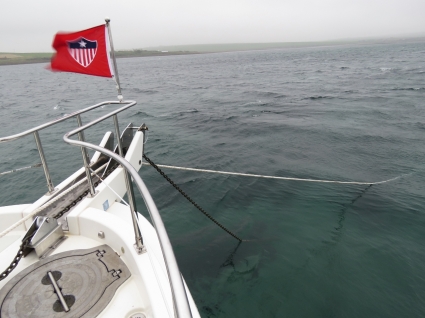
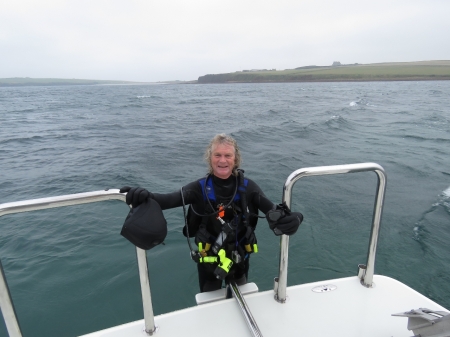
Hello James, Thanks for sharing such an informative post. With your Guardian 85 secondary anchor I am inferring from the photos that it might have been stored in the anchor well but the dimensions look pretty tight? Can the anchor be dismantled for storage?
We keep one Guardian flat on the foredeck and one on the transom both using simple custom stainless holders. The forward anchor is not particularly noticeable since it’s flat against the deck. We don’t disassemble them but they ship disassembled so you could take them it back down if you chose to.
10-16-2017
Hi James
If you had to purchase an anchor
again which model type would be recommended as your favorite ?? Knowing what you know now!
The Rocna both fits and works well so I suspect we would just buy another where we to need to replace this one.
James:
Great write up.
If you had been unable to free the anchor would another option have been to drop/cut the chain and mark the anchor location with a couple of bouys. Once you hsd rounded up the necessary help you would return and retrieve the ground tackle??
Certainly, we could do that if we were unable to free the anchor. There are many commercial divers in the area so I’m sure that it wouldn’t have been a problem to get more help out there if needed.
James, I enjoyed reading your story. Very nice job recovering the gear.
And remember, If the women don’t find you handsome, they should at least find you handy.
p.s.
Big fan of Red Green
We’re Canadians and lived in Toronto for many years so are also big fans of the Red Green Show.
Very interesting. I’ve noticed that you haven’t dove much recently – when was your last dive before this?
I dive at least monthly, primarily fresh water in the Midwest – around here, the water below 20 feet stays below 50 year round (my last dive the bottom was 46), so 58 sounds nice and refreshing!
Yes, it’s been a long time since the last dive. I’m guessing close to 2 years. Our dry suits need new seals so I’m not crazy about cold water driving. I did this dive in 58F water using a 5mm wet suite only because the dive needed to be done. It wasn’t bad from a temperature perspective but I was only in the water for just under 30 min.
Great story! I looked up the price on that anchor and I would have dove in to save it as well. :)
So true. Releasing that anchor would be expensive, the anchor swivel would add to the bill, and we would also be giving up 500′ of 7/16″ high test chain. Very pricey.
guess we will use a trip line next summer when we are there
There are parts of the world where anchor trip lines are pretty much mandatory and this appears to be one of them.
Wow James, You and Jennifer have faced some stressful challenges on this leg of your voyage. Glad you had the tools, gear and skill sets to overcome these obstacles…and wonderful scenery and travel experiences to make it a distant memory.
Over the years, we have had a variety of these challenges. At the time, many were difficult. But, in retrospect, they never feel as hard when looking back as they felt before they were solved. The anchor problem is already far enough in the past that it seems to only have been a minor annoyance. As you point out, it’s the price we pay for the freedom of taking a private boat to see some of the best places in the world. Priceless!
9.27.2017
Hi
Excellent article on your anchor ensnarement & absolutely awesome underwater photography linkage. Have you considered sharing these photos with designers of Rocna anchor? Perhaps they would be interested in making additional design improvements without compromising it’s intended function ! That area of Orkney Scapa Flow has a fair amount of historical input! Did foul anchorage notes show up on your official navigational paper carriage charts showing Orkney Scapa waters?? Where other boats seen anchored in that area during your stay there? Are there many heavy duty sea anchor buoy’s in that area? if not then you might have wondered why the local vintage native inhabitance weren’t anchoring there commerce over the top of a historical maritime debris field! or perhaps they may not care! I’ve noted over the years many navigational guide books along with other related media isn’t always printed or produced with the best interest of mariners in mind but instead profiteers. Would then thorough research & clues indicate when anchorage should or not take place in an area of historical maritime significance! Taking good coordinates notes of potentially challenging waters & sharing updates in hazards to mariners forums will surly lesson unnecessary risk & promote safety! Be well
Greg, I don’t have any recommendations for Rocna to improve their anchor. It seems like any anchor design that does a good job of holding on a bottom has the potential to get ensnared in a heavy chain. There are many areas on the Scapa flow charts marked as foul and there are submerged wrecks all over the place on the charts but, no, this particular one isn’t charted as either a wreck nor foul. The area is shallow and isn’t a channel leading anywhere so are no sea buoys in the vicinity.
Overall, the Scapa Flow area has a lot of naval history, there have boats lost here during wartime, there have been boats scuttled here, and many boats have been salvaged in the area so it’s not really surprising that the bottom continues to have some risks.
Very interesting and enjoyable read..
We carry an emergency work air supply on board that would give us approximately 15-20min of (light) work time. From your description I’m guessing that this may only have provided enough time to free the main anchor, do you think your second anchor could have been recovered with a line from its head?
Did you feel at risk working on the second anchor with Dirona tugging at her leash.
Good question Mike. My dive computer shows I was in the water for only 20 min but I think it was probably a bit more since I didn’t go deep enough to “start” the dive for the first part of swimming out to the anchor. During the dive, I consumed 1,000 PSI of air which suggests around 30 min at these shallow depths. My guess is the entire dive was in the 25 to 30 min range so technically your 15 to 20 min emergency air system might be enough but there wouldn’t be any headroom. It probably wouldn’t be safe to push that close to your air supply limits. This was with good visibility in shallow water but in less positive circumstances it could have required twice as long to address. Getting the job done with a 15 to 20 min air supply might work but it feel pretty close to danger. A small scuba tank that can give you 40 min to an hour wouldn’t cost much and would allow you to do quick jobs with less risk.
As an example of a time when more time was needed, on our previous boat operating in the Straight of Georgia in Canada, I caught the remains of an old fishnet that had been drifting but didn’t know it right away. After a while a vibration had set in. I dove the boat and found the heavy synthetic rope that the drag net was secured with when in use and wrapped around the prop shaft and heated up and welded together. The vibration was bits of net swinging from this welded mess of plastic. It took me over an hour to get it off. No damage done and not really that hard to address but I needed 80% of an entire SCUBA tank to solve it. Having a tank on board can really help. And, a bit more capacity is nice since you might be nervous or working hard and consuming more air that normal.
You asked “Did you feel at risk working on the second anchor with Dirona tugging at her leash.” Certainly, the forces in play are big enough that you don’t just stick your hand in without thinking. It looks worthy of care but not particularly frightening. Sort of like opening the hood in a car. There are things in there that could really hurt you but, if you are reasonably careful, it’s not risky. I think the same was true here. I approached the anchor from up wind, grabbed it where there didn’t appear to be pinch hazards, put my feet on the heavy chain which was very stable and pulled against the load of the boat. Arguably dangerous but my thinking was I could just let go at any time and fall away from the anchor and the anchor would go the other way. Certainly there is some danger and there were safer alternatives available. For example, if I was willing to do a second dive, I could have set the large anchor again and then got the load off the spare anchor. So, strictly speaking I took more danger than absolutely necessary but it felt reasonable.
That could’ve been quite an expensive loss of gear, so nice work in freeing yourselves. Good job it wasn’t old ordnance ⊙﹏⊙
I think there was a marine archaeological survey done of the Orkney’s Scapa Flow a few years ago which listed sites of scuppered blockage ships, wrecks etc.
Nice underwater photography, too!
That’s a good point Paul. It could have been ordinance. Before heading into the water I was thinking through what I would do if I discovered it was a potentially live power line but I hadn’t thought of the explosives possibility. I guess chain wasn’t the worst of the options :-).
That is quite the story of recovery and problem solving. Given the history of the area during/after WWII and the size of that chain, makes one wonder what ship that might have come from and the story behind it.
Yes, I wonder where the chain came from as well. It’s too shallow for a large boats to anchor. There is no need for a submarine blockage net at that location since it’s far too shallow for even a very small and skillfully operated submarine. Perhaps someone towed the chain into the shallows with the intent to salvage it but couldn’t get it off the bottom? I’m not sure any boat small enough to float in the bay would have the power to tow the chain. It’s a total mystery to us but my best (not very good) guess is that it was used to moor something very large and it sat on the bottom in low tide but I can’t imagine the navy wanting a boat on the bottom and unable to sail at any time and I can’t figure out why any commercial boat that would need a chain of that size would be in that area.
An excellent and well written post! I like your well thought out approach to this particular problem.
Thanks Alan. It’s great to have our Rocna 70 recovered and back in service.